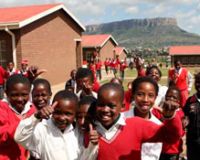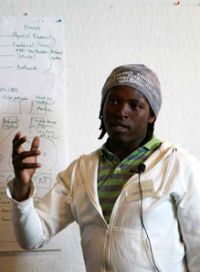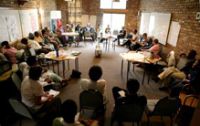
Molibeli Intermediate Phase School in Phuthaditjaba, Free State, one of the 25 pilot schools in the Caring Schools project.
(Image: Nelson Mandela Foundation)Nov 28, 2007 – The needs of children were firmly at the centre of discussions at a dialogue convened by the Nelson Mandela Foundation (NMF) in Clarens, Free State, on Monday.
Facilitator Dr Mothomang Diaho gave each participant a yellow rose, representing a child, to focus the group on its task.
Representatives of government, civil society, schools and communities talked about how schools could care for children made vulnerable by poverty, HIV/AIDS and other causes.

Lebohang Mokoena, a youth facilitator, discusses a caring schools model.
(Image: Nelson Mandela Foundation)In 2006 the Foundation commissioned Save the Children UK to develop a “caring school” model in 25 schools in the Free State. This initiative arose out of an assessment done with the Free State Department of Education on the impact of HIV/AIDS on the educational sector in the province.
Ms Lynette Mudekunye, senior programmes advisor for Save the Children UK, said at the dialogue that schools could reach further into communities than any other service. “Schools should be a place where children want to be: where it’s safe, where physical needs are taken care of, where social and emotional needs are addressed,” she said.
The dialogue also heard from youth facilitators employed by the Caring Schools pilot project to help orphans and vulnerable children mobilise the resources they need. These young people, who come from the communities around the schools in the project, act almost as older siblings. “The children are free with them,” said Ms Mudekunye.
They help children with their homework, organise sports and fun activities, follow up the reasons for absenteeism and refer problems to the appropriate agencies. They have helped many children to get birth certificates and identity documents, for example, so that they can then get government grants. Youth facilitators do not do the work of educators or professionals, however.

Thirty-two people participated in the dialogue.
(Image: Nelson Mandela Foundation)“We have 30 000 schools in this country,” said Mrs Harriet Speckmeier, provincial coordinator for life skills and HIV/AIDS education in the Free State Department of Education. “Imagine if each one had six or seven youth facilitators.”
The departments of education, health, social development and agriculture were represented at the dialogue, along with local government, various nongovernmental organisations and schools. Participants talked about how to co-ordinate their efforts so that the best ideas could be put into practice and sustained.
“We are beginning to see how we have to work together in the future,” commented Dr Connie Kganakga, chief director, HIV/AIDS in the Department of Social Development. “I’m encouraged that we’re beginning to see as our central point the needs of the child.” The next step in the process is to present the recommendations to policy makers for consideration.